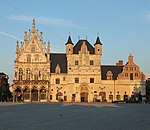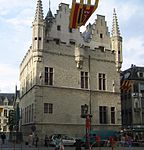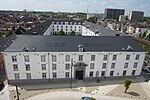Royal Carillon School Jef Denyn
1922 establishments in BelgiumBuildings and structures in MechelenEducational institutions established in 1922Museums in Antwerp ProvinceMusic museums ... and 4 more
Music museums in BelgiumMusic organisations based in BelgiumMusic schools in BelgiumOrganisations based in Belgium with royal patronage

The Royal Carillon School "Jef Denyn" (Dutch: Koninklijke Beiaardschool "Jef Denyn"; informally also the Mechelen carillon school) is a music school in Mechelen, Belgium, that specializes in the carillon. It is the first and largest carillon school in the world. The Belgian government defines it as an "International Higher Institute for the Carillon Arts under the High Protection of Her Majesty Queen Fabiola". The school has trained many of the foremost carillonneurs of the twentieth and twenty-first centuries and houses a rich archive and library.
Excerpt from the Wikipedia article Royal Carillon School Jef Denyn (License: CC BY-SA 3.0, Authors, Images).Royal Carillon School Jef Denyn
Bruul,
Geographical coordinates (GPS) Address Nearby Places Show on map
Geographical coordinates (GPS)
| Latitude | Longitude |
|---|---|
| N 51.026111111111 ° | E 4.4808333333333 ° |
Address
Bruul 54
2800 , Nekkerspoel (Mechelen)
Antwerp, Belgium
Open on Google Maps










